|
|
FARM 13 / STICK MARSH FISHING REPORT
MAY 2003
May 28, 2003
I recently had a great trip out with two really great guys. Tracy Stein and Doug Hay were old friends from way back and made a trip to the Stick Marsh a good excuse to get back together for a visit. It was a grand combination of big-bodied Carolina-rig bass and some finny acrobats busting topwater jerk baits. I sure have a good job!!
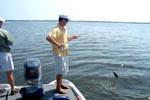 I like fishing that Carolina rig on the shell beds. It is just right for a lazy guide!! I position the boat, drop two anchors to hold the boat in position for both anglers, and then sit on my can and watch them catch them basses. Of course, I have to toss new worms at each guy from time to time. BUT, if I am REALLY lazy that day, I just give each one a bag of 5-inch Zoom pumpkinseed worms and go back to sleep.
I like fishing that Carolina rig on the shell beds. It is just right for a lazy guide!! I position the boat, drop two anchors to hold the boat in position for both anglers, and then sit on my can and watch them catch them basses. Of course, I have to toss new worms at each guy from time to time. BUT, if I am REALLY lazy that day, I just give each one a bag of 5-inch Zoom pumpkinseed worms and go back to sleep.
It almost worked, too. The problem was that Tracy and Doug had bass jumping and splashing by the boat all the time, and I know they were just trying to get me wet and keep me from napping. They did a good job of both, too.
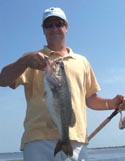 Tracy is a saltwater angler and had extremely limited freshwater experience. To his credit, he picked up on the Carolina rig in near record time and got right into the action. Not being confused by previous ideas about the C-rig, he followed instructions to the letter and it worked like a charm. Here is what a new C-rig angler needs to know:
Tracy is a saltwater angler and had extremely limited freshwater experience. To his credit, he picked up on the Carolina rig in near record time and got right into the action. Not being confused by previous ideas about the C-rig, he followed instructions to the letter and it worked like a charm. Here is what a new C-rig angler needs to know:
- The Carolina rig is used to feel of the bottom. Rough, hard places turn more fish. Find those areas and keep the lure there.
- You don't need a sinker the size of an anchor. Down to 25 feet of depth, a ˝ oz. sinker is just fine and handles a lot better.
- Remember to use a bead with a big hole between the sinker and the swivel. And, keep in mind, the bead is NOT to make noise. That is ludicrous. That big hunk of lead makes so much noise on the bottom that you would never hear the bead, if it did make any racket. No, that bead and its big hole are to fit OVER THE LINE KNOT at the swivel. It is what keeps the weight from beating the knot up and weakening it. That's ALL the bead is for. A good tip is to always use a black bead. A brightly colored one draws bites on it from toothy critters occasionally. Gar and pike love bright colors. They can cut your line in a minute.
- Keep the worm moving. Actually, keep it in motion is what I mean. We don't want a fast retrieve at all. We want that part to be slow. BUT, we want the worm twitching and jumping constantly. Go get an earthworm and drop it in a fish tank or a bucket of water. Immediately you will see what I mean. The worm will NEVER be still until it is dead. Lure action triggers the strike response.
- It is easy to recognize a strike on a C-rig worm. As you pull the lure along, it will occasionally come up against some resistance. That resistance may be a rock, some grass, other obstructions ---- or, it may be a fish. It is simple to determine which it is. All you do is apply a very slight pressure to the line. If it is a fish, it will tug back at you or start to swim off. If it doesn't tug back or swim off, it is NOT a fish. Pretty simple, huh? They key is to never set the hook unless you KNOW it is a bass. I assure you, in 99 of 100 cases, that dumb fish will NOT drop that worm for any reason and will hold it until you determine he is a fish and set the hook. Just ask anyone who has fished with me. They now know that is true.
Anyway, Doug got the ball rolling and was catching fish. Tracy let him get slightly ahead and then proceeded to start catching up. The fish ranged from small bucks to good solid 4-lb.fish.
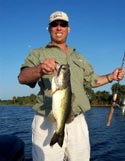 Later, we moved to an area near the ramp to close out the afternoon. Randy Sander's 'Martin' lure was the weapon of choice. The 'Martin' lure is similar to a SENKO or STIK-O jerk bait, only better. It is slightly thinner than either of these other jerk baits, and that really makes the darting-diving action more pronounced.
Later, we moved to an area near the ramp to close out the afternoon. Randy Sander's 'Martin' lure was the weapon of choice. The 'Martin' lure is similar to a SENKO or STIK-O jerk bait, only better. It is slightly thinner than either of these other jerk baits, and that really makes the darting-diving action more pronounced.
Tracy and Doug wasted no time in adjusting to fishing the soft jerk bait in a topwater water manner, with solid fish again coming to the boat. IT was an enjoyable day spent with two great guys.
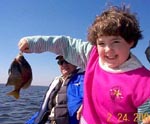 Last year, I had the privilege to spend a great day with Paul and Calene Schweickert, and their young daughter Samantha. Sammy's picture with her first fish is still one of my all-time favorite moments in fishing.
Last year, I had the privilege to spend a great day with Paul and Calene Schweickert, and their young daughter Samantha. Sammy's picture with her first fish is still one of my all-time favorite moments in fishing.
Paul called recently and wanted to set up a bass trip for he and his Father, John. Poppa John knew a thing or two about catching those bass, let me tell you. He and Paul gave the big bass quite a workout. You won't want to miss this fishing report!!!
DON'T you know that 'IF YOU MAKE IT IDIOT-PROOF, SOMEONE WILL JUST MAKE A BETTER IDIOT'.
May 25, 2003
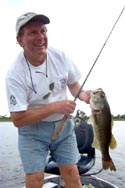 Our good friend, Bill Sargent, is the outdoor editor for the Florida Today newspaper. We first met as members of the Outdoor Writers Association. From time to time, we provide him information on the fishing conditions and forecasts. It seemed all our fishing reports about the Stick Marsh had been getting Bill excited, as he is an avid and very accomplished angler. So we decided it was time to break him away from all the big saltwater tournaments he covers and give him a fishing tour of the impoundment. He got a great tour and found the Marsh bass ready and willing, too! Our good friend, Bill Sargent, is the outdoor editor for the Florida Today newspaper. We first met as members of the Outdoor Writers Association. From time to time, we provide him information on the fishing conditions and forecasts. It seemed all our fishing reports about the Stick Marsh had been getting Bill excited, as he is an avid and very accomplished angler. So we decided it was time to break him away from all the big saltwater tournaments he covers and give him a fishing tour of the impoundment. He got a great tour and found the Marsh bass ready and willing, too!
Our trip encompassed only a few hours, as Bill's Editor had tied him down chasing a possible story about a 1000-lb.+ tuna caught off the Bahamas. The weather was great and the afternoon storms missed us, so we had a choice of a number of fishing methods. Carolina-rigged worms had been hot on the shell beds lately, so that seemed a good bet for quick action.
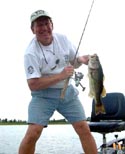 Setting up on one such location, Bill's first cast was right on target. He indicated that he felt the shell bed very well with the big sinker. Almost immediately, he was on to a decent bass.
Setting up on one such location, Bill's first cast was right on target. He indicated that he felt the shell bed very well with the big sinker. Almost immediately, he was on to a decent bass.
That proved to be an indication of things to come, as the fish cooperated very well right there on the edge of the big canal that divided the Farm from the Stick Marsh.
Moving over to the Farm side, we started on an intersection of two canals. Bluegills or needlefish nipped at the plastic offerings, but the bass weren't home at that location. Moving about 50 yards south on one of the canals, we tossed the C-rigs to a shell bed I had only recently discovered. BANG - CRASH!! The bass were ready and willing.
This particular way to fishing for bass in the Farm 13/Stick Marsh impoundment is a strong producer and is an excellent alternative to fishing the present grass mats and their hoards of knats and blind misquotes. I get a lot of emails and telephone calls about how to effectively find shell beds, so I will attempt to provide some basic data here and now:
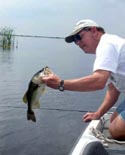 Shell beds are ALWAYS found on high spots. That spot might only be a foot higher than the surrounding terrain. The reason is that Mother Nature gave the shell creatures the instinct for survival and She ingrained one prime directive into their tiny brains: Don't get buried by silt and sand or you will suffocate and die. All living shell creatures live generally by having a constant flow of water through their systems. From that flow, they extract food items and other nutrients. If they grow on a low spot, the silt that settles from the water may eventually cover them and they would die. So, they ALWAYS select a high spot to start their colonies. The levees that border the submerged canals of Farm 13 are perfect and the shells enjoy a pretty safe life. Other shells bed locations can be found simply by watching the depth finder for small changes in the bottom contour. If you see a location that is higher than the surrounding terrain, put that heavy c-rig sinker across it and feel of that bottom. An easy way to find shell beds on the levees is to look for places where the grass on the levees is thin, or does not seem to exist. Sample those places with the c-rig. Shell beds are ALWAYS found on high spots. That spot might only be a foot higher than the surrounding terrain. The reason is that Mother Nature gave the shell creatures the instinct for survival and She ingrained one prime directive into their tiny brains: Don't get buried by silt and sand or you will suffocate and die. All living shell creatures live generally by having a constant flow of water through their systems. From that flow, they extract food items and other nutrients. If they grow on a low spot, the silt that settles from the water may eventually cover them and they would die. So, they ALWAYS select a high spot to start their colonies. The levees that border the submerged canals of Farm 13 are perfect and the shells enjoy a pretty safe life. Other shells bed locations can be found simply by watching the depth finder for small changes in the bottom contour. If you see a location that is higher than the surrounding terrain, put that heavy c-rig sinker across it and feel of that bottom. An easy way to find shell beds on the levees is to look for places where the grass on the levees is thin, or does not seem to exist. Sample those places with the c-rig.
Also remember, each levee probably had a small drainage ditch along its outside and a farm road right along the ditch. (They had to have routes for the farm equipment and harvesting trucks/trailers.) The roads were probably a bit higher than the fields so they would not be muddy. Roads, then, become places where shell beds may grow. When the Farm 13 grass becomes thickly matted on the surface, you can usually see the trace of these roads, as well as the ones that went across the fields. The vehicles (and probably some gravel) made the roadbeds hard and grass does not grow well on hard bottom material.
Bass like shell beds because they are good feeding locations. No, bass do not eat the shell creatures. Instead, the small minnows and other aquatic life come to the shell beds to feed on the algae, tiny organisms, and minute plant life that grow on the hard shells. The tiny minnows draw larger predators and eventually the bass will find prey of sufficient size in the location.
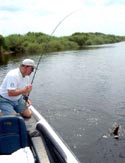 Finding shell beds can be a bit time-consuming, but the rewards can be more than worth effort. Shell beds do not move. Once found, they are constant producers of fish. Of course, the bass may not be on that specific bed every time. But, if you have enough shell beds located, you will always find bass on some of them. Finding shell beds can be a bit time-consuming, but the rewards can be more than worth effort. Shell beds do not move. Once found, they are constant producers of fish. Of course, the bass may not be on that specific bed every time. But, if you have enough shell beds located, you will always find bass on some of them.
Bill and I finished up the day with a quick stop at some grass beds and some topwater action on soft jerk baits. This particular pattern is really super right now and will out-produce hard-bodied topwater plugs 5-to-1.
I recently had a great trip out with two really great guys. Tracy Stein and Doug Hay were old friends from way back and made a trip to the Stick Marsh a good excuse to get back together for a visit. It was a grand combination of big-bodied Carolina-rig bass and some finny acrobats busting topwater jerk baits. We'll play 'show and tell' about the trip next time.
Here's a good saying: 'MONEY MAY NOT BUY HAPPINESS, BUT IT MAKES THE MISERY A WHOLE LOT EASIER TO TAKE!'
May 17, 2003
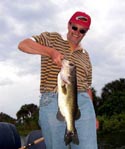 Our good friend, Walt Hoover, called and said he wanted to set up another trip on the Marsh and he wanted to bring his boss along. Dr. Bob Vertes had never fished and didn't even know what a bass looked like. But, he found out rather quickly. And, guess who caught the giant bass of the day??!! Yep, the good Doctor. Our good friend, Walt Hoover, called and said he wanted to set up another trip on the Marsh and he wanted to bring his boss along. Dr. Bob Vertes had never fished and didn't even know what a bass looked like. But, he found out rather quickly. And, guess who caught the giant bass of the day??!! Yep, the good Doctor.
If you recall from previous reports, Walt is a Ph.D. candidate doing his research work in an Alzheimer research center in south Florida. Dr. Vertes is the head of the research center. What they do and what they accomplish may benefit all of mankind. Both are busy folks, so this chance to get in some quality outdoors time was important to them. I was determined to make the trip something special for these two very special people.
Looking for that big bass, as well as large numbers, we started out in the Stick Marsh near coordinates (see our interactive map) C-11. Rigging Dr. Bob up with a Rebel Wee R, I explained about the submerged brush and that he would be hitting it, plus getting hung from time to time. I told him that if you aren't getting the lure hung some then you are not fishing correctly. Then, I gave him the basic lessons in using a spinning rod. Within three casts, the good Dr. had the casting technique mastered and off we went.
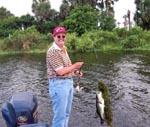 As Walt and Dr. Bob pounded the water to a foamy froth, the bass decided to join in. It was just like the old Batman movies - BAM - CRUNCH - SMASH. Lots of good airborne activity and plenty of good fish. But, alas, no giants. However, there was one in the 6-lb. range, so it was worth the trip. And, Dr. Vestes caught his first bass ever - and then a second - and then a third.
As Walt and Dr. Bob pounded the water to a foamy froth, the bass decided to join in. It was just like the old Batman movies - BAM - CRUNCH - SMASH. Lots of good airborne activity and plenty of good fish. But, alas, no giants. However, there was one in the 6-lb. range, so it was worth the trip. And, Dr. Vestes caught his first bass ever - and then a second - and then a third.
It did not take too long to tire our arms from the rapid retrieve required for this fishing. So, we opted to go to the topwater approach with soft jerk baits. Once again, out came the YumDingers and some super-sharp Gammie hooks.
Arriving in the shallow, grassy flat we planned to fish, a quick lesson was provided to Dr. Bob on how to fish the lure effectively. As luck would have it, the guide's demonstration cast was blown up by a feisty two pounder and both guest anglers had an immediate confidence boost.
As with nearly all anglers new to the topwater soft jerk bait, both Walt and Dr. Bob had to work at disciplining themselves to NOT set the hook on the strike. It is difficult to control your reflexes when a bass explodes on the bait, but it must be done. I got one to hit the lure and then demonstrated how I could lead the bass around like a dog on a leash without ever having set the hook. The bass DOES NOT want to lose his prize and, so long as you don't jerk the line or scare him someway, he will hold that plastic bait forever. After seeing that demonstration, Walt and Bob suddenly felt confident that they did not have to set the hook immediately. In fact, I think they wanted to duplicate what I had done, just to be able to tell someone they had done it, too, and just how dumb a fish really is.
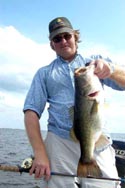 The fish came regularly, with good ones and small ones evenly distributed. One small stretch of submerged grass seemed to hold an exceptional number of bass, so we gradually honed in on it for a series of very productive passes.
The fish came regularly, with good ones and small ones evenly distributed. One small stretch of submerged grass seemed to hold an exceptional number of bass, so we gradually honed in on it for a series of very productive passes.
As the sun turned red in the western sky, I started getting the gear organized to end the day. Walt wound his gear up and stowed his rod, but Dr. Bob was now hooked on bass fishing. He said, 'Let me make a last cast'. In fact, I think he said that about three times. What the heck. We were only two minutes from the ramp, so we let him keep at it.
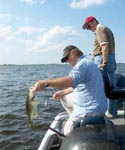 "OK", Dr. Bob exclaimed, "this is really my LAST cast." He dropped the soft bait right next to some floating grass and the fish met it coming down. The sound of the strike, alone, said it was a pretty good bass! He handled the fish as well as any experienced angler would have, keeping her away from the motors and out of the thicker grass beds. After a couple of jumps and 3-4 strong runs, the beautiful 6-1/2 pound bass gave up and floated on her side. After a couple of quick pictures, she was released.
"OK", Dr. Bob exclaimed, "this is really my LAST cast." He dropped the soft bait right next to some floating grass and the fish met it coming down. The sound of the strike, alone, said it was a pretty good bass! He handled the fish as well as any experienced angler would have, keeping her away from the motors and out of the thicker grass beds. After a couple of jumps and 3-4 strong runs, the beautiful 6-1/2 pound bass gave up and floated on her side. After a couple of quick pictures, she was released.
I had never really seen someone smile from ear-to-ear. That is just an expression. But, you know what? Dr. Bob showed us that a person really could have a smile that wide.
Man, I love this job!!!
Our old friend from the Outdoor Writers Association, Bill Sargent, is also the outdoor editor for the Florida Today newspaper. All our fishing reports about the Stick Marsh had been getting him excited, so we decided it was time to give him a fishing tour of the impoundment. He got a great tour and found the Marsh bass ready and willing, too!
One to think about:HE WHO LAUGHS LAST, THINKS SLOWEST!
May 15, 2003
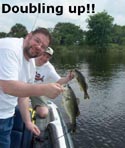 Steve Bell and Clete Starr were in Orlando for some light business and family vacationing. Coming from the Chicago area, they said their bass were not very big at home and wanted to see some Florida specimens. AND, they learned something new by using a lure they had never fished before. Steve Bell and Clete Starr were in Orlando for some light business and family vacationing. Coming from the Chicago area, they said their bass were not very big at home and wanted to see some Florida specimens. AND, they learned something new by using a lure they had never fished before.
As we started out near the ramp area, both anglers wanted to fish a Texas-rigged plastic worm. So, we got them situated where the grass was not too thick and that lure was adaptable. The next thing we know, their lines are crossed. But, it wasn't from one casting over the other. Each had experienced an immediate strike and they were fast into a double. The bass on the right wanted to go left and vice-versa, so things got a bit chaotic for a moment. But, it was a good way to start off, providing some instant adrenaline rushes, laughter and smiles.
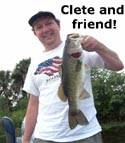 Working the area for awhile, the pair of fishing pals picked up more bass on the worms and had a couple of good ones throw the lure. Then, the action seemed to slow. I knew the fish were stacked in this particular location, because I had been fishing them for about a month. However, I liked to use a topwater approach with a soft jerk bait. So, I asked Steve and Clete to switch over to the YumDinger lure (this is a new soft stick bait that PRADCO is coming out with).
Working the area for awhile, the pair of fishing pals picked up more bass on the worms and had a couple of good ones throw the lure. Then, the action seemed to slow. I knew the fish were stacked in this particular location, because I had been fishing them for about a month. However, I liked to use a topwater approach with a soft jerk bait. So, I asked Steve and Clete to switch over to the YumDinger lure (this is a new soft stick bait that PRADCO is coming out with).
Boy, that was the trick!! The bass generally ate the lure with abandon! Neither angler has fished this way before, so it was easy to teach them the right way to do it. The key was that you just DO NOT set the hook on the strike. That's hard to do, but it has to be done. Just let the bass go with the lure until he takes the slack out and, then, cross his old eyes. Clete and Steve mastered the technique quickly and missed virtually no fish. As we fished on, Steve began to try a slow retrieve, with a stop-and-drop approach. It worked great and even I could sit and watch his line twitch, as a bass would inhale the free-falling lure.
The only problem we had in that selected fishing area was that we turned no large fish. I think we had a strike or two from some good ones, but none were hooked. So, the old guide suggested that we all go out to the Land of the Giants (better known as the open water and submerged brush of the Stick Marsh).
Positioning near the Twin Palms area (approximately at coordinates D-12 on our interactive map), I anchored the boat to maintain stability and to be able to finessed the YumDingers through all the limbs and brush underwater around us.
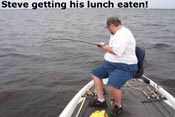 Immediately, Steve was into a nice bass of nearly four pounds. It 'ate his lunch' for a few seconds and then came up out of the wood below. Now, the size of the fish was more of what we wanted. Plus, out in that submerged timber, the odds of encountering a BIG bass are very good (however, getting them up and out of all that wood is another story!).
Immediately, Steve was into a nice bass of nearly four pounds. It 'ate his lunch' for a few seconds and then came up out of the wood below. Now, the size of the fish was more of what we wanted. Plus, out in that submerged timber, the odds of encountering a BIG bass are very good (however, getting them up and out of all that wood is another story!).
Steve re-rigged the soft lure and fired it right back to the same spot that turned the first bass. As the lure sank, Steve and I both saw his line jump six inches, straight up, as another bass inhaled it. Steve gave him a count of three to move off with the lure and then set on the fish hard. Once again, there was a pause as the fish tried to get down into the timber. But, Steve just manhandled him out. This fish was nearly an exact double of the first. Rigging back up again, the angler placed a third cast into the same spot. BAM!! Yet another fish of the same size jumped on the YumDinger! I was beginning to think we were on a school of them, but that was the last one on that location.
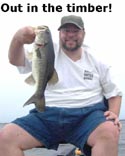 Moving the boat about 50 feet, I actually placed the big STRATOS right between the two old palm tree remains that make up the Twin Palms landmark. Steve Bell had a rabbit's foot in his pocket somewhere and was fast to another good fish in a heartbeat. Clete was beginning to wonder if he was jinxed. Then, his line started swimming off to the left. Seeing as how YumDingers sink well, but swim on a rather seldom basis, this seemed a bit suspicious. So, Clete took up the slack and put the hook to the bass.
Moving the boat about 50 feet, I actually placed the big STRATOS right between the two old palm tree remains that make up the Twin Palms landmark. Steve Bell had a rabbit's foot in his pocket somewhere and was fast to another good fish in a heartbeat. Clete was beginning to wonder if he was jinxed. Then, his line started swimming off to the left. Seeing as how YumDingers sink well, but swim on a rather seldom basis, this seemed a bit suspicious. So, Clete took up the slack and put the hook to the bass.
After a few more fish, the clouds started to build and storms were on the horizon, plus it was getting very late. So, we decided to call it the end of another great day on the Stick Marsh.
I'll bet some Chicago-area bass are going to wish Clete and Steve has never seen that soft jerk bait!!
In our next outing, our good friend, Walt Hoover, brings his boss along. Dr. Bob Vertes had never fished and didn't even know what a bass looked like. But, he found out rather quickly. And, guess who caught the giant bass of the day??!! Yep, the good Doctor. See you then.
Did you ever notice that 'SOMEHOW THE HARDER YOU FISHES, SEEMS LIKE THE LUCKIER YOU GETS!'
May 10, 2003
 We recently got to fish with the most delightful couple you would ever want to share a boat with. Bill and Dawn Manier, from near St. Louis, were in town for Dawn to attend a business conference. Bill saw this as a great excuse to finally get a trip on the famous Stick Marsh. Well, after they returned home, here's what his email to me said "Excellent trip; thank you for a wonderful time!!" Read on and you'll see what he means. We recently got to fish with the most delightful couple you would ever want to share a boat with. Bill and Dawn Manier, from near St. Louis, were in town for Dawn to attend a business conference. Bill saw this as a great excuse to finally get a trip on the famous Stick Marsh. Well, after they returned home, here's what his email to me said "Excellent trip; thank you for a wonderful time!!" Read on and you'll see what he means.
But, I have to tell everyone very honestly that I should have been paying Bill and Dawn for letting me fish with THEM! I enjoyed it that much.
The Maniers were almost newlyweds, having been hitched up only a few years. They met on the Internet while chatting about some subject I forget now. What was so memorable, however, was that they were wrapped up in the chat subject over many months and never realized they were people of the opposite sex. Bill thought Dawn was another guy (she used a chatroom nickname) and Dawn thought the opposite. Somehow, though, the facts eventually got out. And, as Paul Harvey says, 'Now, you know the REST of the story." The chemistry between the two was absolutely wonderful; they were made for each other. We conversed and laughed together the whole fishing trip.
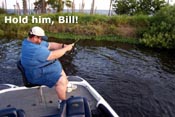 We started out in the western half of the Stick Marsh, tossing those crank plugs the bass seem to love so much. It took a few minutes for Bill to get the hang of the retrieve speed and the lure bouncing off all those limbs and logs. Suddenly, his first fish of the day loaded on and he said, "Oh. So, that's what the fish feels like. It is a lot different from hitting those limbs." From that point on, he had them working on the plug (in this case, a Fat Free Shad medium runner in Citrus Shad color). He even had some of the Marsh's giant bluegills trying to eat the lure.
We started out in the western half of the Stick Marsh, tossing those crank plugs the bass seem to love so much. It took a few minutes for Bill to get the hang of the retrieve speed and the lure bouncing off all those limbs and logs. Suddenly, his first fish of the day loaded on and he said, "Oh. So, that's what the fish feels like. It is a lot different from hitting those limbs." From that point on, he had them working on the plug (in this case, a Fat Free Shad medium runner in Citrus Shad color). He even had some of the Marsh's giant bluegills trying to eat the lure.
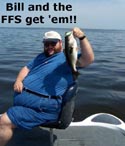 With arms getting tired from the constant fast retrieve necessary to trigger the strikes in the submerged wood, we opted to try something a bit different. So, it was off to some shallow, grass-filled flats and a vegetated shoreline. There, our lure choice would be PRADCO's new YumDinger.
With arms getting tired from the constant fast retrieve necessary to trigger the strikes in the submerged wood, we opted to try something a bit different. So, it was off to some shallow, grass-filled flats and a vegetated shoreline. There, our lure choice would be PRADCO's new YumDinger.
The YumDinger is a Senko-style bait, only better!! It's tougher to last longer and not get torn off the hook so easily. Plus, it has a molded-in hook slot to provide rigging for better hooksets.
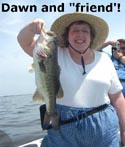 Rigging up with the 4-inch Junebug version of the lure, I demonstrated how it was fished with the most effectiveness. Almost immediately, I was fast to a fish. Bill LIKED that, and he immediately had the confidence factor in place.
Rigging up with the 4-inch Junebug version of the lure, I demonstrated how it was fished with the most effectiveness. Almost immediately, I was fast to a fish. Bill LIKED that, and he immediately had the confidence factor in place.
The bass readily took the soft bait when allowed to sink on a slack line, when retrieved ever so slowly just underwater, and when worked rapidly across the surface. The fast, surface retrieve wound up being used the most, simply because we would see the bass swirl or blow-up on the lure.
Fishing trips like the one with Bill and Dawn are to be remembered with a smile.
Steve Bell and Clete Starr were in Orlando for some light business and family vacationing. Coming from the Chicago area, they said their bass were not very big at home and wanted to see some Florida specimens. Man, did they! AND, they were using a lure they had never fished before. It's a great story.
A Golden Rule about eating out: "If you have to ask what it is, you probably don't want to eat it."
May 2, 2003
Tim Griffin's Mother is a friend of my wife. So, when Dot brought up the fact that Tim had no one to fish with, was a bit too young to have a car, and was sort of 'homebound' during his school break, we made a half-day available.
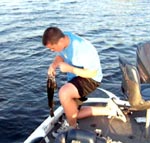 Tim fishes mostly behind his house in a canal and is, therefore, limited in what/ where/how he could fish. He had basically taught himself to fish one lure that was adaptable to that canal environment. And, boy, was that kid GOOD with it!
Tim fishes mostly behind his house in a canal and is, therefore, limited in what/ where/how he could fish. He had basically taught himself to fish one lure that was adaptable to that canal environment. And, boy, was that kid GOOD with it!
We had a bit of a gusty wind problem and only a short afternoon to fish, so I took Tim to an area where there was a good windbreak. That location was shallow with 5 feet of water in the open areas and 3-4 feet right near a vegetation line. The vegetation was along the side of a visible levee and consisted of permanent grass and some floating vegetation that moved with the winds. There were also a few small bushes in the water at random points along the edge of the levee.
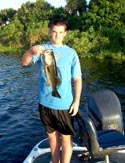 I suggested a lightly weighted Texas rig to start, but Tim asked if he could fish a Bass Assassin jerk bait. It turned out that was about the only lure set-up that he had any experience with, having taught himself to use it in that canal behind his home. It sounded OK with me and I watched Tim rig up.
I suggested a lightly weighted Texas rig to start, but Tim asked if he could fish a Bass Assassin jerk bait. It turned out that was about the only lure set-up that he had any experience with, having taught himself to use it in that canal behind his home. It sounded OK with me and I watched Tim rig up.
He rigged perfectly. Tim said he had watched TV fishing shows and read some magazines that showed how to rig and fish a soft jerk bait. He further indicated that bank fishing along that grassy canal by his home was nearly impossible without using a light, weedless lure of some type. So, he had, by necessity, learned to fish with the soft jerk bait.
I bet I was the most surprised person on the Stick Marsh that day. Tim Griffin could fish that jerk bait as good as anyone I have seen. He was really good with it. With 10-lb. mono and a light rod, he could make that bait do all kinds of tricks. The bass liked it, too. Tim would dance the lure out of the grass and away from the shoreline and the fish would eat that thing!
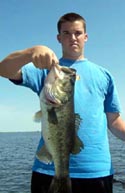 We fished down the grassline for a way, with the jerk bait outfishing my Texas rig by a good margin. Well, my Momma didn't raise any dummies, so I rigged up a STIK-O and proceeded to join the fun. Before long, the dense, sinking STIK-O jerk bait was out-producing the Assassin. My technique was to cast to the grass, pull the lure out a foot away from the vegetation, and then just let it sink on a slack line. I asked Tim if he would like to try my system and he accepted. He adapted to it very quickly.
We fished down the grassline for a way, with the jerk bait outfishing my Texas rig by a good margin. Well, my Momma didn't raise any dummies, so I rigged up a STIK-O and proceeded to join the fun. Before long, the dense, sinking STIK-O jerk bait was out-producing the Assassin. My technique was to cast to the grass, pull the lure out a foot away from the vegetation, and then just let it sink on a slack line. I asked Tim if he would like to try my system and he accepted. He adapted to it very quickly.
As we eased along, I noted that there was some submerged hydrilla showing up in front of the boat, further out in the open water. Closer investigation found that the submerged vegetation has started to grow out into the open water grass near a good landmark we could use for a reference and continued all the way to the end of this particular levee. We also found that it was just slightly under the surface and extended out about 100 feet. So, Tim and I decided to see if there were fish in it, too.
It turned out that the open water was a bit too thick to allow the soft lure to sink effectively. So, we started to work it topwater style, with rapid jerks across the surface and over the grass. Man, what action that produced. Here were a lot of bass that probably had not even seen a lure, since their hideout in the grass was not noticeable. The faster we worked that STIK-O over the grass, the more strikes we generated.
I lost count of the fish caught, but it was a goodly number. And, Tim sure caught his share. A really good one even worked its way in there for him. If he learns to fish other lures and becomes versatile, he may just be that pro we watch on TV some day.
We recently got to fish with the most delightful couple you would ever want to share a boat with. Bill and Dawn Manier, from near St. Louis, were in town for Dawn to attend a business conference. Bill saw this as a great excuse to finally get a trip on the famous Stick Marsh. Well, after they returned home, here's what his email to me said "Excellent trip; thank you for a wonderful time!!" You'll see what he means in our next report.
Deep thought for today: "He who hesitates is probably right!"

Today's Weather for
the Stick Marsh Area
Past Stick Marsh Fishing Reports
Farm 13 / Stick Marsh Information Guide
Email questions to jporter@jimporter.org.
|
Recommended sites by The Fishin' Tipster |
A common question that we get: "Is there somewhere close to get bait and tackle?" This is where we get our bait.

Pete and Tina Heinz / 9 South Mulberry St. / Fellsmere, FL 32948 / 772-571-9855
Get your site listed here
Let us help you drive more targeted traffic to your site.
|


Rank our Site
©Copyright 2001-07 All rights reserved by Jim Porter, any reproduction, quotation or other use of this site or its elements is prohibited without the express written permission of Jim Porter
|
|


 FROGG TOGGS RAIN GEAR
FROGG TOGGS RAIN GEAR
THE BEST PRICES AVAILABLE!!


|
|







